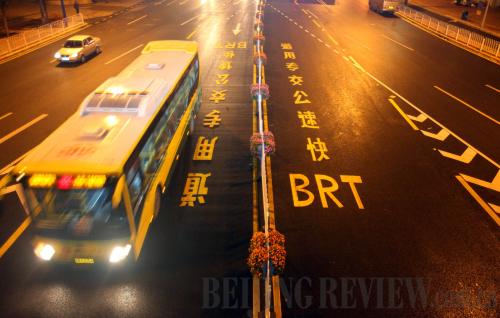|
 |
|
A POSSIBLE CURE: A bus travels on Guangzhou's bus rapid transit (BRT) lane. The city won the 2011 Sustainable Transport Award granted for its BRT system that integrates with bike lanes, bike share and metro stations (CHEN MENGXING) |
In an effort to alleviate congestion, Guangzhou, capital city of south China's Guangdong Province, was considering collecting higher road-use fees from motorists, said the city's traffic authorities.
Guangzhou had almost 2.15 million registered vehicles at the end of 2010, an increase of more than 300,000 from a year earlier. Every 1,000 local residents has more than 90 cars.
The number of private cars in Guangzhou has grown at an annual rate of 22.1 percent over the past five years. The figure is 20.9 percent in Beijing and 21.5 percent in Shanghai.
The Guangzhou Municipal Government has published 30 congestion-tackling measures for public debate between January 23 and March 5. The measures involve collecting congestion fees similar to those imposed in Singapore and London, raising parking fees and encouraging the use of the public transit system.
In the next five years, Guangzhou will begin construction of 11 new rail routes and put 3,000 additional buses into downtown services, in hopes of boosting the ratio of public transit users to 70 percent from 59.6 percent last year.
Encouragingly, Guangzhou won the 2011 Sustainable Transport Award granted by New York City-based Institute for Transportation & Development Policy on January 24, for its new bus rapid transit system that is praised for featuring great integration with bike lanes, bike sharing facilities and subways.
Guangzhou also plans to further reform the use of official cars, which have long been blamed for contributing to traffic jams.
However, Guangdong will not copy Beijing's practice of limiting vehicle registrations, because allowing more residents to own private cars was part of the provincial government's campaign to build a "happy Guangdong," said Guangdong Governor Huang Huahua.
Fundamental solutions
Many traffic management experts believe current measures could only alleviate jams in various cities while the fundamental solution lies in the optimization of the urban planning.
Chen Yanyan, a professor at the Transportation Research Center of Beijing University of Technology, told Legal Weekly the essential cause of traffic jams in most Chinese cities is the supply-demand imbalance in traffic facilities. She quotes a theory of U.S. urbanist Anthony Downs, widely known as the Downs' Law, to explain the cause of congestion: Travel demand on major roads rises to meet capacity.
According to the rule, if new lanes are added, congestion problems might be lessened in the short term, but the promise of reduced congestion will attract drivers who previously used other routes, traveled at different times of the day, drove less or used other forms of transportation, which boils down to the fact that capacity will rarely relieve congestion in the long run.
Chen said Beijing's failure just proved Downs' Law correct. Though Beijing has invested hugely in building roads over the last few years, the expanded road network failed to address the worsening traffic jams.
Chen's center started to cooperate with the BMCT to study Beijing's traffic demand as early as 2005. She believes the solution to the city's traffic problems lies in the control of its demand.
"Reducing residents' traffic demand cannot be solved through increasing parking fees or levying congestion fees, but requires a reform in overall urban planning," Chen said. "Beijing's traffic problems, especially the tidal floods of daily commuters, are mainly caused by urban sprawl. Urban planning also falls into the scope of the broader traffic demand management. Moreover, policies, regulations and the optimization of the road network and public transit system must be used together to manage traffic demand."
| 